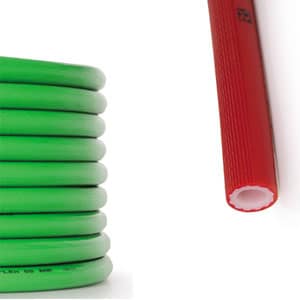The recent advancements in high-performance PVC compounds have significantly enhanced their utility in industrial applications, offering improved durability, chemical resistance, and environmental sustainability.
Polyvinyl Chloride, commonly known as PVC, is one of the most widely used synthetic materials today. Its popularity stems from its versatile properties, which include durability, chemical resistance, and an excellent cost-to-performance ratio. In industrial applications, PVC’s role is pivotal, ranging from construction materials and electrical conduits to automotive parts and medical devices. However, as industries evolve and demand more robust materials, high-performance PVC compounds have become a focal point of innovation. This article delves into the advancements in high-performance PVC compounds and their implications for industrial applications.
The Evolution of PVC Compounds
PVC has undergone significant transformations since its mass production began in the early 20th century. Initially valued for its insulative properties in electrical wiring, the material has expanded into myriad sectors. The evolution of PVC compounds is marked by the integration of various additives and modifiers that enhance its physical and chemical properties. These include plasticizers for flexibility, impact modifiers for strength, stabilizers for thermal resistance, and fillers for cost reduction and improved mechanical properties.
Breakthroughs in Additive Technologies
The latest advancements in high-performance PVC compounds are largely due to breakthroughs in additive technologies. New formulations of heat stabilizers have extended the thermal capabilities of PVC, allowing it to withstand higher temperatures without degrading. This is particularly beneficial in applications such as high-temperature cables and automotive components.
Impact modifiers have also seen significant improvements. The development of core-shell rubber impact modifiers, for instance, has enabled PVC to maintain its rigidity while significantly enhancing its impact resistance. This makes high-performance PVC more suitable for construction materials that require both structural integrity and durability.
Plasticizers and Phthalate Alternatives
Plasticizers are critical in making PVC flexible. However, traditional phthalate plasticizers have raised health and environmental concerns. In response, the industry has shifted towards high-performance non-phthalate plasticizers that provide the necessary flexibility without the associated risks. These new plasticizers are designed to be less volatile and more permanently bound to the PVC matrix, reducing the risk of leaching and volatilization.
Enhancements in Processing and Manufacturing
Advancements in the processing and manufacturing of PVC compounds have also contributed to their high performance. The development of better mixing and compounding techniques has resulted in more uniform dispersion of additives, leading to PVC with more consistent properties. Additionally, the use of computer-controlled reactors in PVC polymerization has improved the precision of the molecular weight distribution, enhancing the material’s mechanical properties.
Sustainability and Recycling
Sustainability is a pressing concern in all areas of manufacturing, and PVC production is no exception. High-performance PVC compounds are now being developed with an eye towards recyclability and environmental impact. Bio-based plasticizers, derived from renewable resources, are being incorporated to create more sustainable PVC compounds. Moreover, the industry is focusing on the development of PVC formulations that are easier to recycle, thereby reducing the material’s environmental footprint.
Applications in the Industrial Sector
The industrial sector has greatly benefited from these advancements in high-performance PVC compounds. In the construction industry, for example, PVC is used in window frames, pipes, and roofing materials. The improved thermal and impact resistance of high-performance PVC compounds has extended the lifespan of these materials and reduced maintenance costs.
In the automotive industry, high-performance PVC is used in under-the-hood components, interior trims, and sealants. The enhanced thermal stability and chemical resistance of these compounds allow them to perform reliably in the harsh conditions of the automotive environment.
The electrical industry also utilizes high-performance PVC in insulation and sheathing for cables and wires. The improved fire-retardant properties and thermal stability of advanced PVC compounds have made electrical systems safer and more durable.
Future Directions for PVC Compounds
The future of high-performance PVC compounds looks promising, with ongoing research and development focusing on further enhancements. One area of interest is the incorporation of nanotechnology to create PVC nanocomposites with superior strength, durability, and electrical properties. In addition to this, PVC compounds now have the ability to self-heal major damages and wear, extending their useful life even further.
Takeaways on PVC Compounds
The advancements in high-performance PVC compounds are a testament to the material’s adaptability and the industry’s commitment to innovation. By continuously improving the properties of PVC, manufacturers are able to meet the ever-increasing demands of industrial applications. These developments not only enhance the performance and sustainability of PVC but also pave the way for new applications that were previously unattainable. As industries continue to push the boundaries of material science, high-performance PVC compounds will undoubtedly play a key role in the materials of the future.
About Us: Why Choose Terraflex
At Terraflex, we pride ourselves on being at the forefront of innovation and quality in the hose manufacturing industry since our inception in 1968. With over half a century of expertise, we have established ourselves as a leading manufacturer of PVC hoses and a variety of other plastic hose products.
Our commitment to excellence is evident in our rigorous attention to quality, durability, and the functionality of our products. We cater to a diverse range of sectors, including agriculture, infrastructure, and the marine industry, ensuring that our hoses meet the specific needs of each domain.
Our state-of-the-art manufacturing processes and dedication to customer service mean that when you choose Terraflex, you’re opting for a partner that not only provides superior hose solutions but also understands the intricacies of your industry. We are not just a supplier; we are a partner in your success, offering products that stand the test of time and perform under pressure, just like our hoses. Choose Terraflex, where innovation flows through everything we do.

